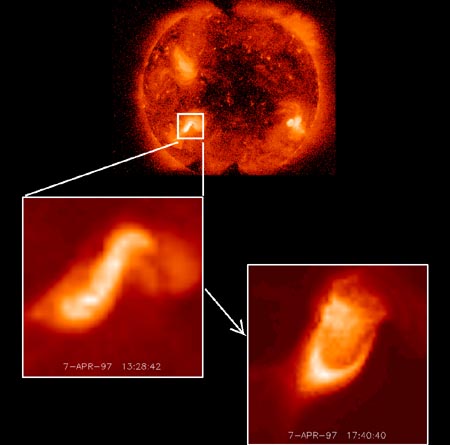Explanation: On the Sun, S marks the spot. Solar explosions have been discovered to explode preferentially from regions marked with this letter. The surface of the quiet Sun is a maze of hot gas and flowing magnetic fields. When two regions of high magnetic field strength approach each other, they typically pass uneventfully. If the two regions pass close enough and in just the right way, however, an X-ray bright S-shaped region called a sigmoid forms and quickly explodes in a Coronal Mass Ejection (CME). Astronomers conjecture that in the center of the sigmoid, a circuit closes that somehow drives the explosion. The above picture shows the Sun in X-ray light. A pre-CME sigmoid is shown on the left inset image, while a post-CME arc is shown in the right inset.
1999 2000 2001 2002 2003 2004 2005 2006 2007 2008 2009 2010 2011 2012 2013 2014 2015 2016 2017 2018 2019 2020 2021 2022 2023 2024 2025 |
Yanvar' Fevral' Mart Aprel' Mai Iyun' Iyul' Avgust Sentyabr' Oktyabr' Noyabr' Dekabr' |
NASA Web Site Statements, Warnings, and Disclaimers
NASA Official: Jay Norris. Specific rights apply.
A service of: LHEA at NASA / GSFC
& Michigan Tech. U.
|
Publikacii s klyuchevymi slovami:
Sun - surface - Solnce
Publikacii so slovami: Sun - surface - Solnce | |
Sm. takzhe:
Vse publikacii na tu zhe temu >> | |
